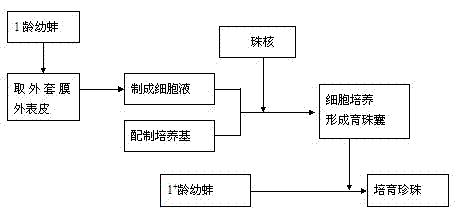Method for cultivating pearls in test tube
A cultivation method and test-tube technology, applied in fish farming, application, climate change adaptation, etc., can solve the problems of low degree of application and industrialization, inability to increase added value, and restrict the sustainable and healthy development of the pearl industry. quality effect
- Summary
- Abstract
- Description
- Claims
- Application Information
AI Technical Summary
Problems solved by technology
Method used
Image
Examples
Embodiment 1
[0020] Such as figure 1 As shown, a method for cultivating test-tube pearls: first, select 1-year-old chrysalis juveniles, cut off the marginal membrane of their mantle, peel off the outer skin of the marginal membrane by tearing the film, wash and disinfect, and cut into 0.5 mm-sized cell fragments; then, put the cell fragments into a culture flask, add trypsin digestion solution with a concentration of 0.3 parts (parts by weight) and a pH value of 7.2, and place in a constant temperature incubator at a temperature of 25°C Digest for 15 minutes, filter with 200-mesh silk net to remove excess tissue pieces, add a small amount of inactivated and sterilized body fluid of chrysalis to make epithelial cell fluid; secondly, use RPMI1640 basic medium with a total volume of 45 parts (by weight) , 30 parts of total volume (parts by weight), calf serum of 15 parts (parts by weight) of total volume, and an appropriate amount of penicillin and streptomycin are prepared into a complete m...
Embodiment 2
[0022] A method for cultivating test-tube pearls: first, select 1-year-old chrysalis juveniles, cut off the marginal membrane of their mantle, peel off the outer skin of the marginal membrane by tearing the membrane, wash and disinfect, and cut into cells with a size of 1 mm. Small pieces; then, put the small pieces of cells into culture flasks, add trypsin digestion solution with a concentration of 0.3 parts (parts by weight) and a pH value of 7.2, and digest them in a constant temperature incubator at 25°C for 20min. 200 mesh tulle filter to remove excess tissue pieces, add a small amount of inactivated and disinfected body fluid of the chrysalis to make epithelial cell fluid; secondly, use 50 parts (by weight) of RPMI1640 basic medium, 40 parts (by weight) ), 20 parts (by weight) of calf serum and appropriate amount of penicillin and streptomycin to prepare a complete culture medium, so that the concentration of penicillin and streptomycin is 100IU / ml; again, the prepared P...
Embodiment 3
[0024] A method for cultivating test-tube pearls: first, select 1-year-old chrysalis juveniles, cut off the marginal membrane of their mantle, peel off the outer skin of the marginal membrane by tearing the membrane, wash and disinfect, and cut into 0.5mm-sized pearls. Small pieces of cells; then, put the small pieces of cells into culture flasks, add trypsin digestion solution with a concentration of 0.3 parts (parts by weight) and a pH value of 7.2, and digest them in a constant temperature incubator at 25°C for 15min. Use 200 mesh silk screen to filter and remove excess tissue pieces, add a small amount of inactivated and sterilized mussel body fluid to make epithelial cell fluid; secondly, use 55 parts (by weight) of RPMI1640 basic medium, 50 parts (by weight) Parts) of the body fluid of the chrysalis, 25 parts (by weight) of calf serum and an appropriate amount of penicillin and streptomycin to prepare a complete medium, so that the concentrations of penicillin and strepto...
PUM
 Login to View More
Login to View More Abstract
Description
Claims
Application Information
 Login to View More
Login to View More - R&D
- Intellectual Property
- Life Sciences
- Materials
- Tech Scout
- Unparalleled Data Quality
- Higher Quality Content
- 60% Fewer Hallucinations
Browse by: Latest US Patents, China's latest patents, Technical Efficacy Thesaurus, Application Domain, Technology Topic, Popular Technical Reports.
© 2025 PatSnap. All rights reserved.Legal|Privacy policy|Modern Slavery Act Transparency Statement|Sitemap|About US| Contact US: help@patsnap.com

